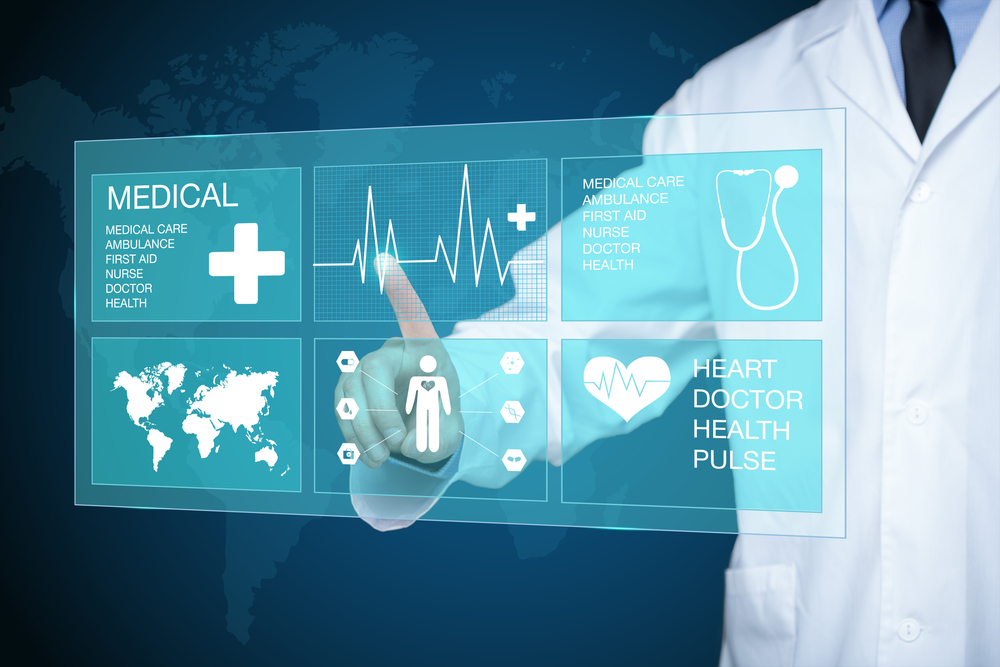EMR systems have emerged as a critical cornerstone in the healthcare industry over the past few years. EMRs are digital versions of traditional paper-based medical records. They store and organize patient data, including medical history, diagnoses, medications, laboratory results, and treatment plans.

These digital repositories have revolutionized the way healthcare providers manage patient information, enabling efficient and secure storage, retrieval, and sharing of medical data. While adopting EMR systems has brought about transformative benefits, it’s not without its own challenges.
From interoperability issues to concerns about data security, traditional EMR systems face a range of complexities.
What is EMR technology?
As aforementioned, EMR (electronic medical record) technology represents a paradigm shift in how healthcare information is created, stored, and shared. These solutions typically store a wide range of patient data, including medical history, diagnoses, medications, laboratory results, and treatment plans. EMR technology can be used by a variety of healthcare providers, including physicians, nurses, and pharmacists.
An EMR platform can be divided into three main components, i.e., database, user interface, and communication bridge.
1. Database
All the data input to an EMR platform is stored in a database. This includes patient demographics, medical history, laboratory results, treatment plans, and much more. EMR databases can either be onsite servers or cloud-based storage. Regardless, these databases are structured to make it easy for users to access, manage, and edit data.
2. User Interface
The user interface includes all the tools and design elements that enable users to interact with the EMR platform and the data stored in it. EMR user interfaces must be designed to be easy to use and navigate. This is important because healthcare providers need to be able to access and manage patient data quickly and easily in order to provide efficient and effective patient care.
3. Communication Bridges
Communication bridges are essential for any EMR platform to ensure its wide functionality. They allow EMR systems to share patient data with other healthcare systems, enabling providers to coordinate care and ensure that patients receive the best possible care. EMR communication bridges typically use healthcare data exchange standards, such as HL7 or FHIR. This allows EMR systems to communicate with each other, even if they are from different vendors.
Significance of EMR Technology
The adoption of EMR technology has catalyzed monumental advancements in the healthcare industry. One of the pivotal advantages lies in the accessibility and portability of records. With EMRs, healthcare providers can retrieve patient information swiftly, regardless of their location. This is particularly invaluable in emergency situations where immediate access to accurate medical data can be a matter of life and death.
Moreover, the digital nature of EMRs also enables the integration of decision-support tools, enhancing clinical decision-making. Alerts for allergies, potential drug interactions, and evidence-based treatment guidelines can be integrated into the system, providing an additional layer of safety and efficacy in patient care.
Common Challenges Faced by Traditional EMR Solutions
1. Interoperability & Data Integration
Interoperability and data integration are two of the biggest challenges faced by EMR systems. Unfortunately, many traditional EMR systems operate in silos. Each system may have its own architecture, data standards, and protocols, making it arduous to bridge the gap between different platforms. This leads to fragmented and isolated pockets of patient information, inhibiting the comprehensive view necessary for informed decision-making.
There are a number of factors that contribute to the interoperability and data integration challenges faced by EMR systems. One major factor is that EMR systems are often developed by different vendors, each with its own proprietary data format. This makes it difficult for EMR systems from different vendors to communicate with each other.
The lack of interoperability and data integration between EMR systems can have a significant impact on patient care. For example, if a patient sees multiple healthcare providers, each provider may have their own EMR system. This can make it difficult for healthcare providers to coordinate care and ensure that patients receive the best possible care.
Additionally, the lack of interoperability and data integration can make it difficult for patients to get a complete picture of their medical history. This can make it difficult for patients to make informed decisions about their care.

However, the aforementioned HL7 and FHIR exchange standards are initiatives directed towards addressing these issues of increasing isolation and interoperability challenges among different EMR platforms. These standards provide a common way for different EMR systems to communicate with each other. Health information exchanges (HIEs) are another initiative putting efforts to solve this problem. In simple terms, HIEs are organizations that connect different EMR systems and allow healthcare providers to share patient data.
2. Ease of Use & Training Needs
EMR systems, while powerful, are not immune to the complexities that can arise from their very sophistication. Ensuring that these systems are user-friendly and that healthcare professionals are adequately trained to navigate them is crucial for their successful implementation. Some EMR platforms, due to their intricate features and functionalities, can be daunting to navigate. The sheer volume of options and interfaces can overwhelm healthcare professionals, potentially leading to inefficiencies and errors in recordkeeping.
The lack of ease of use and the need for training can have a significant impact on patient care. For example, if providers are frustrated with the EMR system, they may be less likely to use it properly. This can lead to errors and gaps in care. Additionally, if providers are not properly trained on how to use the EMR system, they may not be able to use all of the features of the system effectively. This can limit their ability to provide high-quality patient care.
There are a number of things that healthcare organizations can do to improve the ease of use and training of their EMR systems. One thing that healthcare organizations can do is to choose an EMR system that is designed to be easy to use. Additionally, healthcare organizations can go with EMR companies, like OphyCare, that provide training to health workers on how to use the system effectively.
3. Data Security & Privacy
The safeguarding of patient information is of paramount importance in any healthcare setting. EMR systems are tasked with not only storing vast amounts of sensitive data but also ensuring that it remains confidential, secure, and protected from unauthorized access. Patient data encompasses a variety of highly sensitive information, including medical history, diagnoses, treatments, and personal identification details. Ensuring the confidentiality and integrity of this data is not only a legal and ethical obligation but also a matter of patient trust and confidence.
The lack of data security and privacy can have a significant impact on patient care. For example, if patient data is breached, patients may be at risk of identity theft or medical fraud. Additionally, the lack of data security and privacy can damage the reputation of the healthcare organization.
There are a number of things that healthcare organizations can do to improve the data security and privacy of their EMR systems. One thing that healthcare organizations can do is to implement robust security measures, such as firewalls, intrusion detection systems, and encryption. Additionally, healthcare organizations should train their staff on data security best practices.
Compliance with regulatory standards is a non-negotiable aspect of EMR implementation. Healthcare providers and institutions must adhere to stringent guidelines, such as HIPAA (Health Insurance Portability and Accountability Act) in the United States, to ensure the protection of patient data.
4. Customization and Adaptability
In the healthcare industry, no two institutions are exactly alike. Each has its unique workflows, preferences, targeted populations, and requirements. It is imperative that EMR systems can flex and adapt to accommodate these specific needs without sacrificing standardization. EMR systems need to be customizable to meet the specific needs of different healthcare organizations and providers.
Customization enables healthcare providers to tailor the EMR system to their specific workflows. However, it can be expensive and time-consuming, and it can be difficult to maintain a balance between customization and standardization. Customization can encompass everything from templates and forms to specialized modules for specific specialities. Fulfilling these unique requirements can often lead to issues with compliance with industry and regulatory standards.
Fortunately, companies like OphyCare and Meditech are leading the industry in developing EMR solutions that strike the perfect balance between following the industry standards and offering extraordinary customization options that cover the unique needs of almost every healthcare organization serving anywhere in the world.
5. Cost and Resource Allocation
Implementing and maintaining an EMR system is a substantial undertaking, and it comes with its own set of financial considerations and resource allocation challenges. Smaller healthcare facilities may face challenges in allocating the necessary resources to implement and use an EMR system effectively.
The transition to an EMR system involves significant upfront costs. This includes expenses related to software licenses, hardware infrastructure, data migration, training programs, and potential consulting fees. Furthermore, ongoing expenses, such as subscription fees, maintenance, updates, and the cost of support personnel, must be factored into the budget. Balancing these financial considerations is a critical aspect of successful EMR adoption.
There are a number of things that smaller healthcare facilities can do to reduce the cost and resource burden of implementing and using an EMR system. The first and most important thing that healthcare facilities can do is to choose an EMR system that is based on cloud-backed storage. Additionally, smaller healthcare facilities can consider partnering with other healthcare organizations to share the cost of implementing and maintaining an EMR system.
Future Trends & Innovations in EMR Solutions
In the world of electronic medical records (EMRs), exciting advancements are on the horizon. Technologies like artificial intelligence (AI), machine learning (ML), cloud computing, and blockchain are set to transform the landscape.
AI and ML bring automation and personalization to EMR systems, enhancing care quality. They can swiftly generate crucial reports, detect potential drug interactions, and suggest tailored treatment plans. These technologies empower healthcare providers with timely information, ensuring a patient-focused experience.

Cloud computing offers a game-changing advantage, streamlining EMR implementation and maintenance. Cloud-based systems are more flexible and cost-effective, adapting seamlessly to evolving healthcare needs.
Blockchain steps in as a guardian of privacy and security. By using a distributed ledger, it creates an unalterable record of patient data, safeguarding it from unauthorized access or tampering.
While these technologies are in the early stages of adoption, their potential to revolutionize patient care through EMRs is undeniable. The future looks promising. EMR solutions are gearing up to be more efficient, secure, and patient-centric. Interoperability is on the rise, promising a brighter future for healthcare.
Conclusion
EMR systems are an essential part of modern healthcare. They help healthcare providers to provide better patient care, improve efficiency, and reduce costs. However, EMR systems also face a number of challenges, such as interoperability, ease of use, data security and privacy, customization and adaptability, and cost and resource allocation.
Emerging technologies are poised to address these challenges and make EMR systems even more powerful and effective tools for healthcare providers. AI, ML, and cloud computing can help to improve the interoperability, ease of use, security, privacy, customization, and adaptability of EMR systems.
Additionally, EMR systems are becoming more patient-centric and interoperable, which will lead to better patient care.
One leading EMR company that is developing innovative solutions to the challenges faced by traditional EMR systems is OphyCare – an AI-based EMR platform. This platform is designed to be easy to use, secure, and adaptable. OphyCare is also working to improve the interoperability of its EMR platform with other healthcare systems.
OphyCare is committed to helping healthcare providers deliver better patient care. OphyCare intelligent medical record (IMR) is designed to give providers the tools and information they need to make informed decisions and provide high-quality care to their patients.



